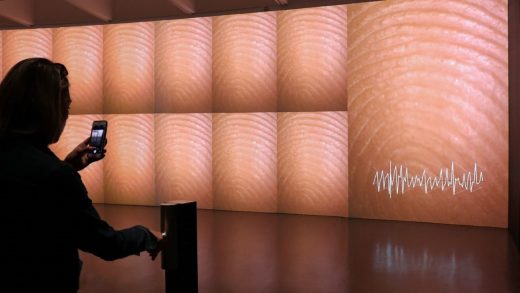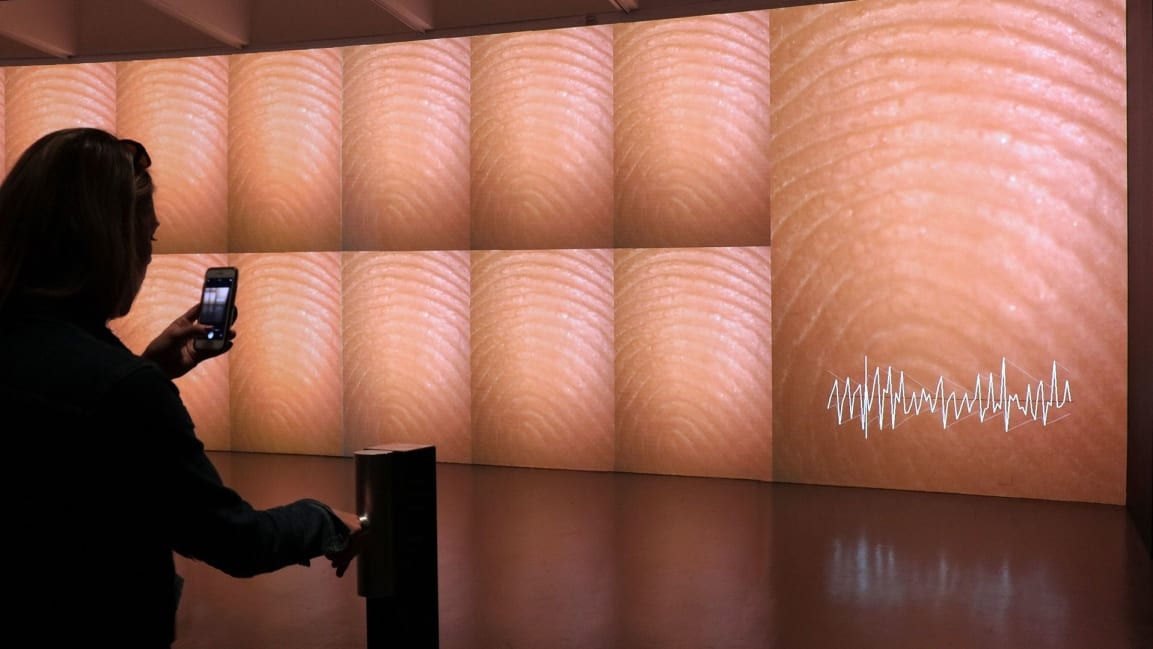How Rafael Lozano-Hemmer uses your biometric data to create art
Known for incorporating technology and design into his artwork, Mexican-Canadian artist Rafael Lozano-Hemmer is exhibiting his immersive public art installations together for the first time under one roof at Washington, D.C.’s Hirshhorn Museum. In the exhibit, called Pulse, which closes at the end of the week, Lozano-Hemmer uses interactive technology to interpret the vital signs of visitors. Biometric signatures–fingerprints, heartbeats–of each visitor are recorded as repetitive sequences and translated into immersive sound experiences, waves in water tanks, and flashing lights.
In the first piece in the exhibit, Pulse Index, participants’ fingerprints and heart rates are recorded via a custom-made sensor and displayed along with the fingerprints of the past 10,000 participants on a grid, pulsating to their heartbeat. In Pulse Tank, participants’ heartbeats are turned into ripples in an illuminated water tank, creating patterns that are then reflected on gallery walls. In the last piece in the exhibit, Pulse Room, rows of light bulbs hang from the ceiling and pulsate to the rhythm of the heartbeats of past visitors. As more visitors pass through, the heartbeats travel down the row until it ends.
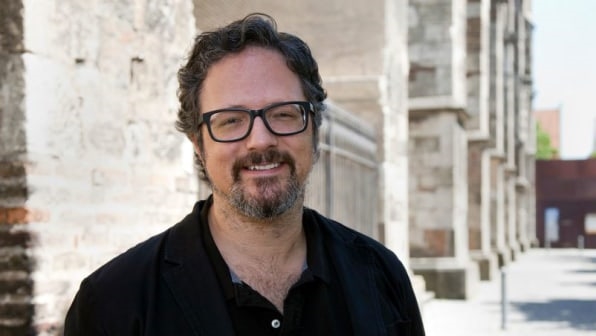
We recently spoke with Lozano-Hemmer about the project’s custom-made technology and what it’s like to create art out of personal data.
Fast Company: How did you first come up with the idea for the Pulse series?
Rafael Lozano-Hemmer: There’s two answers. The personal, emotional story is that my wife was pregnant with twins and I’m a nerd, I’m a geek, so being a nerd, I learned that an ultrasound machine can actually listen to the heart of the fetus. I asked for two ultrasound machines so I could listen to the heart of the boy and of the girl. When we did this, they created this beautiful music and syncopation. They created this minimalist, repetitive rhythm that I thought was beautiful. I thought, what if we did this kind of thing with a large number of people? How could we use these vital signs in a more open or architectural way?
So in 2005 I made an artwork called Pulse Room, which measures your heartbeat and lets you view it in the context of 300 past participants. More intellectually, I am very concerned but also curious about the age of metrics. These days everything is quantified. People get detected and tracked and there is a virtual profile of each and every one of us, which can be used for political reasons. We live in an age of metrics and machine learning and computer vision and statistics. It’s a challenge for artists to use those technologies for objectives that are not corporate or Orwellian but rather to create connective and critical installations. That’s what I tried to do here.
FC: Can you tell us about the technology you used for the Pulse series?
RLH: In the case of the Pulse series, we’re using existing technology: The Pulse Room uses over-the-counter sensors you might find at a gym. In the case of Pulse Tank, we’re using the changes in the opacity of your finger. There is a light that gets shined, which detects the speed at which blood gets pumped through it. At my studio we have 14 assistants; half of them are engineers or programmers or industrial designers and half of them are artists or architects. We put all of these disciplines together. We develop technology only if it’s necessary and because it’s inevitable.
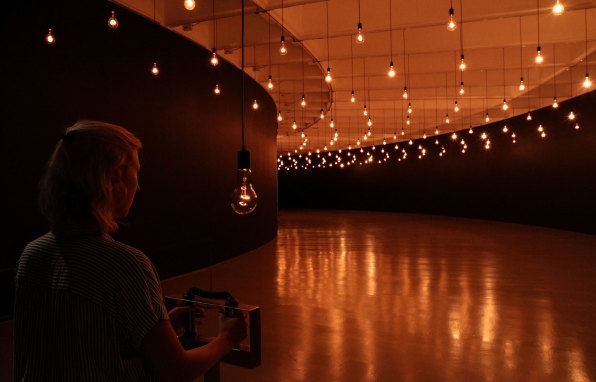
In my field, people talk about new media. Sometimes there is this kind of fetish for novelty. That’s not what I’m doing. When I say that increased use of technology in art is inevitable—we all live in a globalized economy. Technology dictates how war is waged, and the way elections are won or lost . . . Marshall McLuhan said in the ’60s that technology is the second skin. We can’t pretend it’s a tool outside our body. North Americans watch [screens] eight hours a day. This is who we are. If we want to speak about today and we need to work with the languages of today, that is technology. The art world can go to enormous lengths to not participate in this new technological shift or they can embrace it–I embrace it.
FC: Are there any pieces of art, where technology was used, that have inspired you?
RLH: There is a piece by Marta Minujin from 1965 called La Menesunda. She used close-circuit TV to track members of the public. I love to mention this precedent because the very first usage of video in art was done by a Latin-American woman 54 years ago. It breaks the stereotype. We are actually talking about decades of experimentation. Decades of experimental practice that I and my work are part of. What I’m doing has a lot of precedents. Jean Dupuy’s heartbeat-activated sculpture. I’m aware of all these precedents. At the Hirshhorn show, we have a chronology where you can hear about the use of fingerprints and tech in art that goes 100 years back, which allows you to see the context.
FC: Do you identify as a Latin-American artist?
RLH: I do a lot of research about technological precedents in Latin America to break the stereotypes. I find it troubling when people define what Latin-American art is. There are so many different types or art in Latin America, many of which are geeky or nerdy like mine. I don’t want to be someone who represents all Latin-American artists.
FC: Why did you choose to make your artwork interactive?
RLH: My work is incomplete on it’s own by nature. It’s a humbling thing because you depend on participation. Involving people creates relationships. They sense that they are being represented. The public is in on the process. In all three artworks, you share a fingerprint or a heartbeat, and they become the content of the piece itself. There is a complicity with the installation. At this time, when people are taking so many selfies, there is a resonance there because people see themselves portrayed. At the same time, their participation gets immediately subsumed into a landscape because their data is incorporated into the larger piece anonymously.
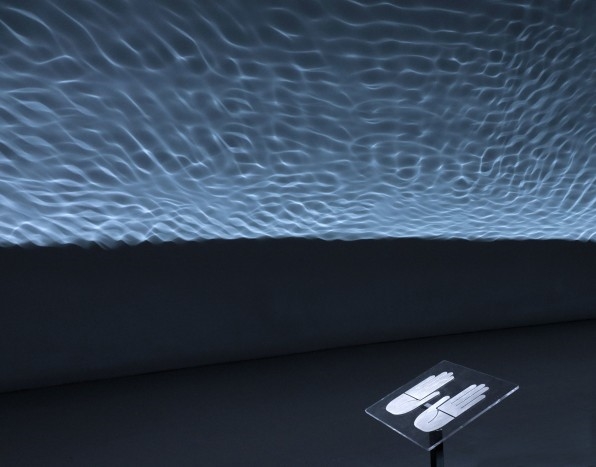
FC: Why did you decide to collect biometric data, like fingerprints and heartbeats?
RLH: Fingerprinting is used to decide who is legal and who is illegal. It’s a violent technology at work. Fingerprinting was first used in Argentina as a biometric that helped identify criminals. In the U.S., this type identification can help undo the Trump administration’s brutal policy of separating parents from children. In my work, we take that fingerprinting and use it to create a sense of connection, instead of for control. I wanted to have your fingerprint help you participate in a collective experience, rather than identify you not as someone who is accountable to the system. Anonymity emerges as a result of your participation. You can see tens of thousands of fingerprints.
FC: You previously exhibited your work in large public spaces like Madison Square Park. Does it feel different to exhibit in The Hirshhorn?
RLH: The museum is not a neutral space. We are often asked to go to a museum to be inspired by what is on display and see what is deemed important by the intelligentsia. The experience is quite different. The beautiful thing about public space is that it’s out of control. It’s a place where you don’t get as many levels of intermediation. People could stumble upon the artwork as they go home from work. Their participation is far more surprising. It’s more political because the diversity you can get in public space is of course greater if people choose to go to a museum–especially if it’s a paying one. In a museum, you think about what you’re doing and what has happened in the past.
FC: Have any visitor reactions surprised you at the museum?
RLH: For people who have different cardiac conditions, like an arrhythmia, it’s not a pleasant experience. Your heartbeat can take over the whole museum, and it’s quite uneasy to hear an arrhythmic heart take over a museum. I have found people are able to empathize with the person who has the condition. With the light bulbs, eventually your own heartbeat would disappear. When families participated, and followed the heartbeats down, it was beautiful. It just reminds us of that fragility and how long we are alive.
FC: Has exhibiting your work in D.C. felt different from exhibiting them in other cities or countries?
RLH: It’s super corny . . . but as a Mexican-Canadian, the idea of bringing my art to the mall in D.C. in this political climate is about humanity. It’s about how we represent humanity and how we can evade the violence and antagonism that the current administration is imposing on this country and on the planet. Maybe it’s a mistake to turn around and see this all through the lens of Trump because he is a temporary problem, but I can’t help myself. I think of when the fascists took over Spain in the civil war and the intellectuals of the time went there to stop the regime of Franco. I think we are undergoing something similar. It is the job of the artists. We have a historical responsibility to speak out.
(15)

